 Once you’ve selected and sized your dust collector to meet the specific needs of your application, it’s crucial to address several additional factors to ensure that this vital piece of equipment operates both efficiently and reliably. Whether you’re installing a baghouse, cartridge filter, cyclone, or a combination of these dust collection systems, meticulous attention to detail during both the pre-installation and post-installation phases can significantly impact performance and longevity. Here’s an expanded guide covering essential aspects to ensure a seamless installation and optimal operation of your dust collection system:
Once you’ve selected and sized your dust collector to meet the specific needs of your application, it’s crucial to address several additional factors to ensure that this vital piece of equipment operates both efficiently and reliably. Whether you’re installing a baghouse, cartridge filter, cyclone, or a combination of these dust collection systems, meticulous attention to detail during both the pre-installation and post-installation phases can significantly impact performance and longevity. Here’s an expanded guide covering essential aspects to ensure a seamless installation and optimal operation of your dust collection system:
Sizing and Placement
- Verify Dimensions and Fit:
- Detailed Measurements: Before proceeding with installation, meticulously recheck the overall dimensions of the dust collector. This includes not only the dust collector unit itself but also the space required for ancillary components such as fans, discharge valves, collection containers, and ductwork.
- Planning for Future Needs: Consider future expansion or modification needs. If you anticipate additional equipment or changes in the system, ensure that the space you allocate can accommodate these future upgrades without requiring significant reconfiguration.
- Allow for Maintenance Access:
- Routine Maintenance Space: Adequate space around the dust collector is essential for routine maintenance tasks such as changing filters, inspecting components, and performing necessary adjustments. This space should also facilitate safe and efficient work, reducing downtime and improving overall system reliability.
- Emergency Access: Plan for easy access in case of emergencies. Quick access points can make it easier to address unexpected issues or system failures, minimizing potential operational disruptions.
- Consider Environmental Factors:
- Ventilation: Ensure that the installation location has adequate ventilation to prevent overheating and to maintain the effectiveness of the dust collection system. Poor ventilation can lead to decreased performance and increased wear on equipment.
- Temperature and Humidity Control: Evaluate and manage environmental conditions, including temperature and humidity. Extreme temperatures or high humidity levels can affect the performance and lifespan of the dust collector, potentially causing operational problems or premature equipment failure.
- Space for System Components:
- Clearances for Components: Account for the space needed for all system components, including bracing, supports, and controls. Adequate clearance helps prevent interference with system operations and facilitates easier installation and future maintenance tasks.
- Accessibility for Ductwork: Ensure that there is sufficient space for installing and accessing ductwork. Proper ductwork design and installation are critical for maintaining efficient airflow and preventing dust buildup within the system.
Discharge Airlock Valve
- Select the Appropriate Valve:
- Compatibility with Dust Type: Choose a valve that is suited to handle the specific type of dust being collected. For example, abrasive dust may require a valve with durable components, while sticky dust might need a valve designed to prevent clogging.
- Airlock Efficiency: The valve should provide a reliable airlock to prevent pressure drops within the system. Proper airlock functionality ensures that dust is efficiently removed from the collector without disrupting the overall system pressure.

- Regular Inspection for Wear and Leaks:
- Check for Component Wear: Regularly inspect the valve for signs of wear and tear. Components such as flanges, shafts, and seals should be checked for damage or degradation, as these can lead to leaks and reduced efficiency.
- Leak Detection: Implement routine checks for leaks around the valve. Addressing leaks promptly can prevent reduced system performance and minimize potential operational disruptions.
- Evaluate Valve Options:
- Automatic vs. Manual: Consider the benefits of automatic valves over manual ones. Automatic valves can provide power and maintenance savings and enhance the consistency of dust removal. They can also integrate with automated control systems for improved efficiency.
- Power and Maintenance Costs: Analyze the total cost of ownership, including power consumption and maintenance requirements. Automatic valves may offer long-term cost benefits by reducing manual intervention and optimizing performance.
- Integration with Control Systems
- Automation and Monitoring: Integrate the discharge valve with your control systems for real-time monitoring and performance management. Automated systems can provide valuable insights into valve operation, detect issues early, and facilitate proactive maintenance.
- Data Collection and Analysis: Utilize data collected from control systems to analyze valve performance and identify trends. This information can help in making informed decisions about maintenance schedules and system adjustments.
While these considerations might seem fundamental, neglecting them can lead to significant challenges and increased costs. Addressing the dimensions, placement, and operational aspects of the dust collector and its components with careful planning and attention to detail can enhance the efficiency and longevity of your dust collection system. By prioritizing proper installation, maintenance, and monitoring, you can avoid common pitfalls, reduce downtime, and ensure that your dust collection system remains a reliable and effective component of your process equipment.
Investing time and effort into these preparatory steps will pay off in the form of a smoother installation process, improved system performance, and reduced long-term costs
To improve efficiency and safety, there is no substitute for an on-site inspection by an experienced expert. Click below to start with a free 20-minute phone consultation by clicking the button.

